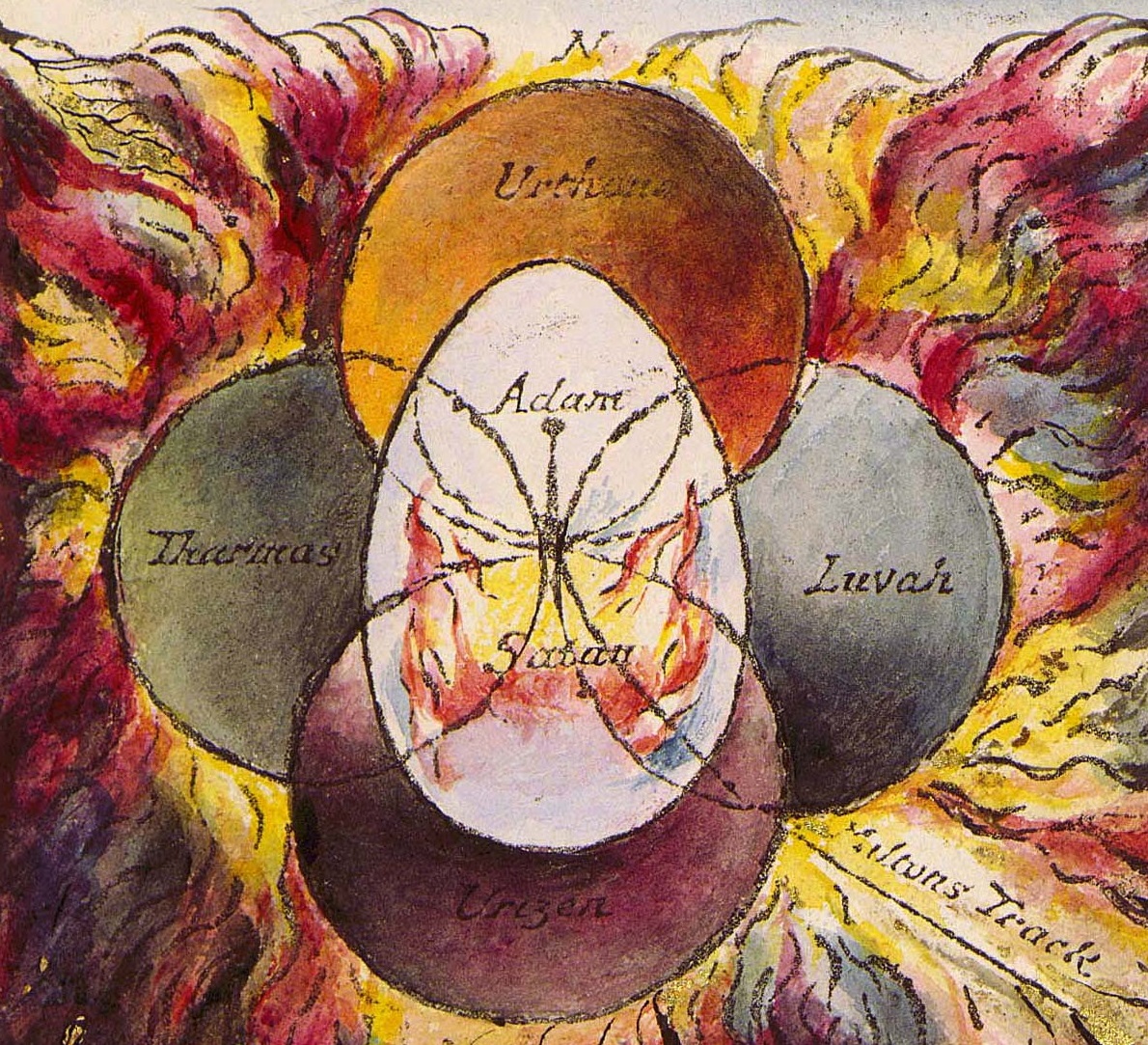Tharmas on:
[Wikipedia]
[Google]
[Amazon]
In the mythological writings of 
William Blake
William Blake (28 November 1757 – 12 August 1827) was an English poet, painter, and printmaker. Largely unrecognised during his life, Blake is now considered a seminal figure in the history of the poetry and visual art of the Romantic Age. ...
, Tharmas is one of the four Zoas
In the mythology of William Blake, Albion is the primeval man whose fall and division results in the Four Zoas: Urizen, Tharmas, Luvah/ Orc and Urthona/ Los. The name derives from the ancient and mythological name of Britain, Albion.
Sources
In ...
, who were created when Albion
Albion is an alternative name for Great Britain. The oldest attestation of the toponym comes from the Greek language. It is sometimes used poetically and generally to refer to the island, but is less common than 'Britain' today. The name for Scot ...
, the primordial man, was divided fourfold. He represents sensation, and his female counterpart is Enion In the mythological writings of William Blake, Enion is an Emanation/mate of Tharmas, one of the four Zoas, who were created when Albion, the primordial man, was divided fourfold. She represents sexuality and sexual urges while Tharmas represent ...
, who represents sexual urges. He is connected to the God the Father aspect of the Christian Trinity and is the begetter of Los. Tharmas is mostly peaceful, and flees during most of his fights with Urizen. He is depicted in various ways ranging from a youth with wings to an old bearded man.

Character
Tharmas is both the last Zoas described but also the first in the number. His aspect as a Zoas is Sensation. As connected to the Trinity, Tharmas is seen as God the Father. As a body part, he is the loins with hisEmanation Emanation may refer to:
* Emanation (chemistry), a dated name for the chemical element radon
* Emanation From Below, a concept in Slavic religion
* Emanation in the Eastern Orthodox Church, a belief found in Neoplatonism
*Emanation of the state, a l ...
/mate Enion representing sexual urges. He is also represented as a shepherd. Tharmas is connected to the direction point West and his fallen state is to mark the Circumference of the world. His elemental connection is to water and, in turn, to time. His artistic aspect is Painting and his particular sense is Tongue, which represents taste and speech. He represents both free speech but also false speech. In his divine state, Tharmas is peaceful and idyllic. However, during the war among the Zoas, he fights until he is defeated and falls. His name is possibly a back formation from their daughter's name, Enitharmon. Tharmas is the unifier of the Four Zoas. When Tharmas vanishes, he is replaced by chaotic nature.
As connected to the body and sensation, his fallen state's separation from Enion/sex causes him to turn into the spectre Eternal Death. Through Enion, he creates poetic instinct along with the children forms of Urthona/Los and Enitharmon. When separated from Enion, she creates the "Circle of Destiny", and, with it, the Gate of the tongue, which Tharmas is connected to, was closed. He is at conflict with himself, and through the conflict he becomes human. This caused him to hate, and he feels thwarted by being unable to have sex. He seeks out Urthona/Los and Enitharmon to redeem the universe, but Los refuses and Tharmas separates Urthona/Los and Enitharmon, which causes Urthona to become the spectre Los. However, he soon reunites them. Tharmas battles against Urizen, but normally ends up fleeing. During the Last Judgment, Tharmas and Enion are seen as two children and are able to experience an idealistic sexual relationship. They are also able to assume their divine forms and Tharmas awakens both Los the Eternal Prophet and Albion the Eternal Man. They join in with the harvest after the Final Judgment
The Last Judgment, Final Judgment, Day of Reckoning, Day of Judgment, Judgment Day, Doomsday, Day of Resurrection or The Day of the Lord (; ar, یوم القيامة, translit=Yawm al-Qiyāmah or ar, یوم الدین, translit=Yawm ad-Dīn, ...
.
Appearances
As part of Blake's later myth, Tharmas appears in ''Milton'' with a description of Tharmas relationship with Los and the building of Golgonooza. Tharmas creates the foundation but leaves as Los sets about rebuilding the universe. The ''Four Zoas'' describes Tharmas's disputes with Urizen and Tharmas constant fleeing from various fights. The work also reveals his origins along with his role within the Last Judgment. ''Jerusalem'' defines other aspects of Tharmas, including his connection to the tongue and speech. Tharmas also assumes many forms in Blake's various designs and illustrations. He is depicted in the designs as a young, winged man that lies near the Sea of Time and Space. He is in despair. The designs depicting him in ''Jerusalem'' show a bearded man that is shaping the circumference of a sphere while Enion is chasing after the young Los and Enitharmon. In the "Circle of Life" design, he is young and without a beard, and, in Blake's illustrations of Genesis, he has the head of an ox.Damon 1988 pp. 399–401Notes
References
* Bloom, Harold. ''The Visionary Company''. Ithaca: Cornell University Press, 1993. * Damon, S. Foster. ''A Blake Dictionary''. Hanover: University Press of New England, 1988. {{William Blake, myth William Blake's mythology